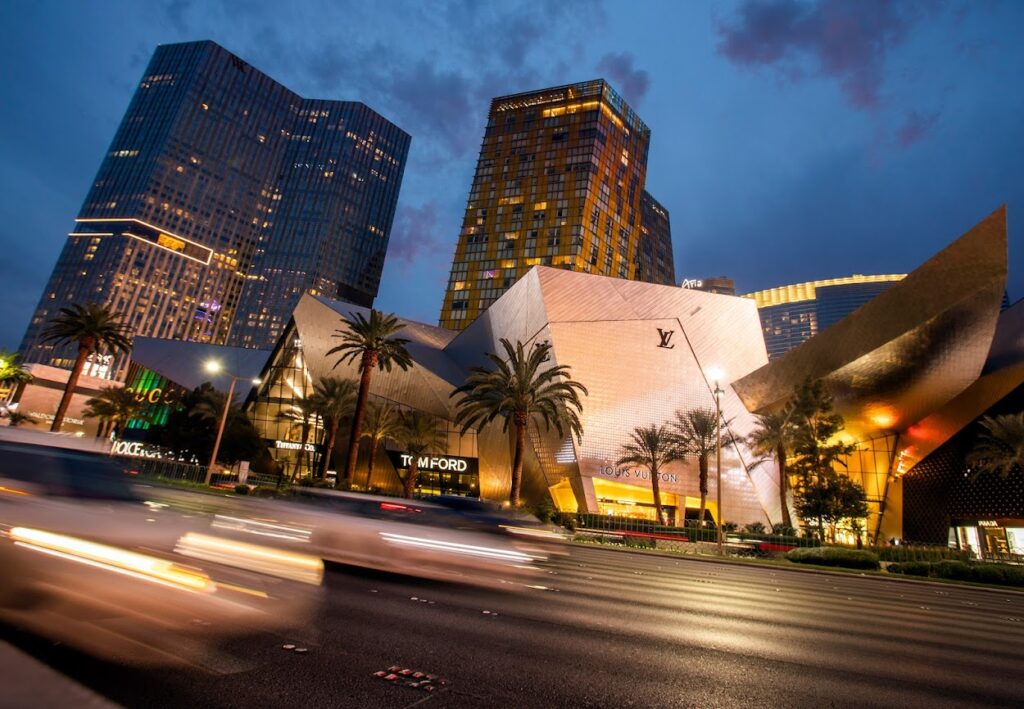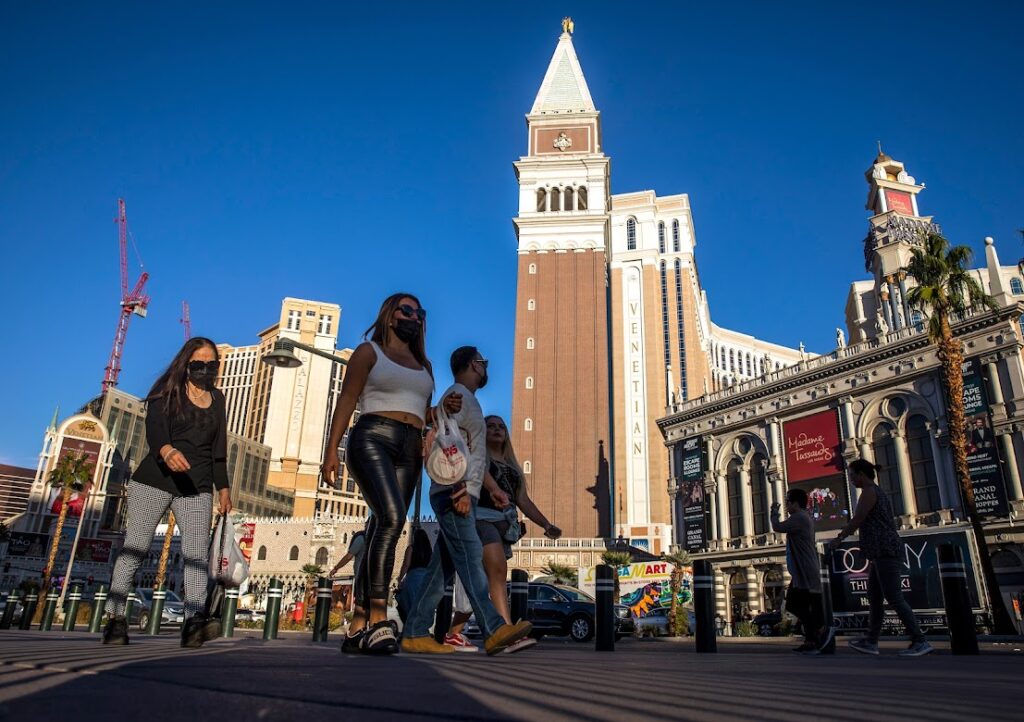Strip’s failed condo market remains quiet, but analysts hint at a comeback

Hiding beneath a torn and disintegrating tarp that mimics the neighboring Venetian and Palazzo resorts, the unfinished St. Regis condominium tower stands at the center of the Las Vegas Strip.
The structure is a symbolic monument to an era more than a decade ago when the gaming industry sought to blend high-rise residential complexes into the international tourist destination.
Except for a handful of projects, the concept failed.
When Las Vegas Sands halted construction of the planned $600 million St. Regis in 2008, Nevada and the nation were in the grips of the Great Recession. The gaming industry saw casino revenues tumble nearly 20 percent over two years while financing evaporated for dozens of high-rise development and resort projects.
“Starting in 2004 to 2008, it seemed like every piece of dirt in the resort corridor had a proposed condo project planned for it,” CBRE Global Gaming Group Executive Vice President Michael Parks said. “The financing for the condo projects dried up and the sales prices were falling. Based on the construction costs, the projects just didn’t pencil out.”
At the time, the target market for Strip condominium buyers ran the gamut from those seeking investment properties for resale or rental, to people seeking a vacation home or primary residence.
Brian Gordon, principal of Las Vegas-based financial advisory and economic research firm Applied Analysis, agreed the timing of the recession destroyed the Strip’s burgeoning high-rise condominium market.
“The majority were in pre-sales or in a construction run-up during the peak and subsequent market fall-off,” Gordon said. “Those dynamics generally limited their ability to remain viable. The market was overheated for any number of reasons and when the music stopped, it made many of these projects no longer feasible.”
Brendan Bussmann, a partner with Las Vegas-based Global Market Advisors, said accelerated costs for construction at the time “basically sent the condo market into junk bond status.” He said developers of many of the combined hotel and condo projects planned to use proceeds from residential sales to fund a portion of the development. However, amid the recession, sales dropped off and prices fell.
“Using the upfront money helped lower the debt structure of the overall project,” Bussmann said. “The condo market took the biggest tumble at that point because it had lost nearly all of its value, well beyond that of regular housing.”
Applied Analysis issued a research report in the third quarter of 2007 showing more than 150 luxury condominium projects in some phase of development or planning in the Las Vegas Valley.
More than 80 percent of those projects – 87,000 of the 104,000 conceptual residential units – were expected to be located on the Strip, south of the Strip, just off the Strip or in the downtown corridor.
Unlike Las Vegas Sands’ St. Regis project, most hadn’t begun construction or were in very early stages of development.
There were, however, a few success stories.
MGM Resorts International completed Signature Towers at MGM Grand in 2006 and Veer Towers at CityCenter in 2009. The Palms Place tower was completed by the original owner of the off-Strip Palms Casino Resort in 2008. All three are sold out.
Nearly two dozen condominium towers not connected to a hotel-casino also were completed, starting with the construction of the Turnberry Place development on Paradise Road in 2001.
Residential real estate broker Bruce Hiatt, who specializes in the high-rise condominium market for the Luxury Realty Group of Las Vegas, said the high-rise resale market across Las Vegas is “starting to percolate again in the resort corridor,” primarily because of the nearly $2 billion Allegiant Stadium.
The 65,000-seat complex is scheduled to host numerous concerts and special events in 2022 in addition to serving as the home stadium for the NFL’s Las Vegas Raiders and the UNLV football team. The stadium also hosts college football preseason and postseason games, including Thursday’s Las Vegas Bowl. Allegiant Stadium also will host the NFL’s Pro Bowl on Feb. 6 and was recently named the site for the 2024 Super Bowl.
“The buyers of these high rises want to be able to come in, and then lock it up and leave, or rent it,” Hiatt said. “But they want the amenities when they come to the town.”
He said the resale market is picking up and starting to entice “long-term rental” buyers.
However, Hiatt blamed Clark County’s restrictions on short-term rentals having “turned off certain buyers.”
In response to what lawmakers said was an overall frustration over an ineffective ban on short-term rental properties, the Legislature this year passed a bill aimed at standardizing rules, including holding hosting platforms such as Airbnb or Vrbo liable for non-compliance with local regulations.
On Tuesday, Clark County released a survey to gauge the opinions of residents on developing an ordinance related to short-term rentals. AB363 requires the county to enact an ordinance by July 1.

A comeback, but not soon
The potential for new development on the Strip reheated in 2021, following the June opening of the $4.3 billion Resorts World Las Vegas. In a speech, the chairman of Malaysia-based Resorts World developer, K.T. Lim, alluded to planning out a second phase on more than 20 acres of the 87-acre site that remains undeveloped.
In 2020, Circus Circus owner Phil Ruffin said he was considering options for the undeveloped portions of the more than 100-acre North Strip land parcel he acquired at the end of 2019. And, on Dec. 13, Florida’s Seminole Indian Tribe said it was spending almost $1.1 billion to acquire the operations of The Mirage from MGM Resorts. Through its Hard Rock Entertainment subsidiary, the tribe plans to add a hotel expansion that resembles the body of an electric guitar to the 77-acre Strip site.
Condos aren’t in any of the plans, but some gaming and real estate experts believe a residential component may once again be tried in connection with hotel-casino development — though not any time soon.
“I wouldn't say we'll never see that type of development again,” Parks said. “I wouldn't be surprised if in the next few years, you saw a project on the Strip that either had a condo-hotel component or a pure residential condo component.”
According to Parks, the increase in Las Vegas area real estate prices over the past 24 months, coupled with condominium resale values, could mean potential new developments will start “to pencil out where it makes sense to do ground-up construction.”
Gordon also “wouldn’t rule it out,” noting that the newer properties being developed are far different from the hotel casinos built 20 or 30 years ago. It might be easier, he said, “to integrate a residential component” into the overall development.
“While it has been pretty limited as of late, it could bear some fruit going forward depending on the location of the specific project,” Gordon said. “I think the answer is yes to a mixed-use resort development with some luxury or high-end residential.”
Bussmann said there tends to be “a cycle in real estate development” but he doubts the market would see the scale proposed 10 to 15 years ago.
“The value of Veer and some of the other towers have come roaring back, but it’s taken over 10 years to get there,” he said.
Bussmann also suggested changing habits in how people live, work and play could include an “urban resort-style setting” in Las Vegas.
Nothing, however, is yet on the books.
Fontainebleau developer Jeffrey Soffer, who regained control of the unfinished property after 14 years, said in November the condominium units that were part of the original plans were no longer included in the re-started development.
“It’s not the right fit, and we don’t have to do that now,” Soffer said.
The residential component was included during the initial development to help finance Fontainebleau. Soffer, who developed Turnberry Place and Turnberry Towers in Las Vegas, said standalone condos made better sense financially.
“The condo thing is sort of a thing of the past,” Soffer said of using residential unit sales to fund development costs.


Success and failure
Steel and scaffolding from the St. Regis skeleton are now exposed to passersby on the Strip because the tarp covering the building since 2011 is decaying, The top of the building serves as the base for a construction crane utilized in the current redevelopment of the Tao Beach Club on the roof of the Venetian’s casino.
A spokesman for Las Vegas Sands said the company has no plans to complete the St. Regis tower and that its future is up to VICI Properties and Apollo Global Management, which are in the process of acquiring the company’s Strip holdings for $6.25 billion. Nearly 400 private residences, ranging from 1,700 square feet to 10,000 square feet, were expected to have seven-figure price points.
MGM Resorts found the most success of any casino operator in the high-end residential market. The buildings do not have gaming but are either attached or adjacent to MGM-operated casino resorts.
The three-tower Signature development, built behind MGM Grand between 2006 and 2007, has 1,639 privately owned units. The towers are connected to MGM Grand and owners have the opportunity to utilize MGM’s rental program that is similar to but separate from renting a hotel room at the 5,000-room Strip resort.
A company spokeswoman said in an email that short-term rentals by owners are allowed, and the buildings were set up for the purpose of rental units operating in a “hotel-like” manner. Owners renting their units independently are required to maintain a Clark County business license and pay applicable taxes.
At CityCenter, the company planned three different residential components to coincide with centerpiece Aria Resort Casino in the $9 billion, 67-development. Construction began in 2005 and Aria opened in December 2009.
The residential developments were completed at the same time and sales took place over the next several years. All the residential units in two of the developments have been sold. A third was turned into a non-gaming hotel.
The all-residential Veer Towers has two 37-story buildings housing 335 one-, two- and three-bedroom condos and penthouses ranging from 500 to nearly 3,300 square feet. All were sold. Veer is now managed by a company not associated with MGM Resorts.
The top floors of the 47-story non-gaming Mandarin Oriental Hotel at CityCenter have 225 one-, two- and three-bedroom condominiums ranging from 1,110 to 4,000 square feet. Those, too, were sold. The property was renamed Waldorf Astoria in 2018 after Hilton Hotels acquired the management contract when the property was sold to new ownership.
The non-gaming Vdara was another CityCenter project designed to be a private residential building when the Strip development opened in 2009. The recession caused sales to drop, and only 148 of the 1,495 units were sold. MGM halted sales the units are available for rent. MGM operates Vdara as a non-gaming hotel.
On West Flamingo Road, less than a mile from the Strip, Palms Place sold out its 599 condominiums after it opened in 2008. Many of the owners utilized the Palms Casino Resort reservation system to rent out the units. However, Palms was one of four Red Rock Resort properties that remained closed following the state’s 78-day shutdown of gaming because of the COVID-19 pandemic starting in March 2020.
The property has since been sold to Southern California’s San Manuel Band of Mission Indians, which plans to reopen the hotel-casino by March. Incoming Palms General Manager Cynthia Kaiser Murphey told the Nevada Gaming Commission on Dec. 16 public areas of Palms Place will be renovated and units will again be listed in the hotel’s reservation system.

Living on the Strip
Orange County, California resident Steven Bromberg said he and his wife, Ronnie, were frequent Vegas visitors when they began looking at the Strip condominium market in the mid-2000s. They focused on Signature at MGM, looking for a studio unit with a view of the Strip.
But the residences were far outside of their price range.
“We love the people watching. We love going up and down the Strip. It just never gets old for us,” Bromberg said.
They waited until 2010 and by that time, resale prices had dropped dramatically. A 10th-floor studio unit with a view of the Strip became available and the Brombergs bought it for $146,000 through a short sale.
“I didn’t even know what a short sale was,” Bromberg said of the transaction where a home is sold for less than the balance remaining on the mortgage.
He said an acquaintance who paid $1.3 million for a one-bedroom Signature unit on the 36th floor in the same building sold it for just $350,000.
Bromberg said his 520-square-foot unit, which has a small kitchenette, was in excellent condition when they bought it. He and his wife redecorated with a Vegas-Elvis-Marilyn Monroe theme. They pay $700 a month in homeowner association fees, which includes cable television and phone service. They chose not to include the unit in the hotel reservation system.
Prior to COVID-19, the Brombergs would visit their residence every four-to-six weeks. He hopes they can get back into that routine in the next year. Typically, they arrive on a Thursday and stay through Monday. The couple will visit during the middle of the week, he said, “if we want it a little quieter.”
He said most of the units around his are rentals.
“It’s really a second home to us. The management takes care of business and (Signature) is kept really clean,” Bromberg said. “We go into the MGM, but we like to go everywhere. We love the tourist routine. We're not gamblers. If we spent $20 on a poker machine, that's a big deal.”
